Rhythms of Shakti & AMC's Little Chilli Festival
Female empowerment through music – Rhythms of Shakti
Words by Ashanti OMkar (www.omkari.net)
Pictures by Akin Falope (www.aworan.net)
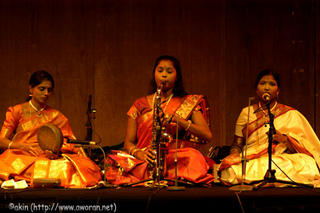
‘The Little Chilli’ festival has become a well known week in the minds of culture fans around the UK, for its devotion to creating a cultural buzz, handpicking the best and most diverse of talents from the South East of Asia. A brainchild of Sitar maestro, Viram Jasani who runs the Asian Music Circuit (AMC - http://www.amc.org.uk/) in London, he meticulously picks unusual and exciting acts and aims to present them in a form that Westerners and Easterners alike can identify with the sheer universality of music - the one force that has the power to unite the world. With a line up that included ‘Cirebonese mask dance’ from West Java in Indonesia; ‘The spirit of friendship’, where Pakistan and India unite with the Qawwali style of the Nizami Brothers; ‘The Hua family Shawm band’, enlivening gypsy musicians from China, ‘Ustad Ghulam Ali’, the famous Ghazal exponent; ‘Kagura’, one of Japan’s oldest performing art, a colourful and vibrant in form of mask dancing; ‘Mrigya’, something more contemporary in form of a Delhi based fusion band; ‘Hindustani vocal’ in the ‘Gayaki’ tradition, by Piu Sarkhel and Amit Mukerjee and in my opinion, the most important and thrilling of all, the Carnatic (South Indian Classical) ensemble, ‘Rhythms of Shakti’, who bring a new voice to female empowerment by having an all female group of talented musicians from Karnataka.
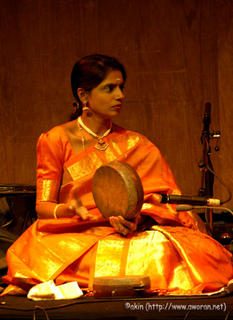
This extraordinary group of female musicians derive their name, ‘Rhythms of Shakti’ from the female energy source, the ‘Shakti’ a universal force that is known to give the feminine it’s divinity, in different ways, from the courage aspect in Hindu Goddess Durga, to the wealth facet in Hindu Goddess Lakshmi and the knowledge characteristic derived from the Hindu Goddess Saraswathi. Led by Lata Ramachar (BR Lata), the celebrated daughter of Kanjira (Small Indian tambourine) ace, HP Ramachar of Karnataka; this group has taken a few monikers and various musicians have rotated in it’s formation - names such as Mahila Laya Madhuri – which toured in places like Abuja, Nigeria for the commonwealth foundation and also as female Ghatam (clay pot) player, Sukanya Ramgopal’s group ‘Stri Taal Tarang’, a group that Lata was very much part of, again consisting of all female members.
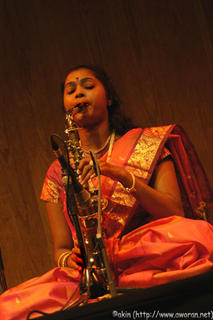
Obviously, this concept may ring a bell, as Anuradha Pal, the Indian Tabla player, student of the great Zahkir Hussain, who also happens to be female and her North Indian variant of ‘Rhythms of Shakti’ called ‘Stree Shakti’ were most celebrated and even went as far as releasing a CD. Lata Ramachar has toured with Anuradha in the past, with Stree Shakti, hence having the sort of experience to be on the international stage. One may ask why this is all so special, the simple answer is that ‘sexism’ exists in India, as it does all over the world and the music side is no exception, where male musicians dominate the field, especially in the percussion arena. Female musicians face many a problem when they decide to learn percussion instruments, one being that particularly South Indian male artistes are reluctant to teach percussion to females and often even refuse to accompany female artistes in their shows, as they feel it demeans their art. This sad scenario has hit many generations, but finally, the light is being seen and groups like ‘Rhythms of Shakti’ are bringing their blend of music to the world, via careful selection by organisations like AMC.
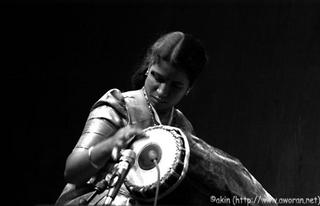
Luckily for Lata Ramachar (who has played for the late MS Subbalakshmi and the great Balamurali Krishna – a definite honour and feat for any female musician), her father took upon the challenge when he saw talent in his daughter and trained her up to a standard that matches any man in her field of playing, the Kanjira in her hands simply ‘sings’; her nimble fingers are dextrous and the rhythmic formations that come out of this tiny tambourine with her miniature hands are simply brilliant in their technique and accuracy. Lata is the only professional Kanjira player that India has to offer, in its rich tapestry of music, but Lata leads the path for many more female percussionists with her hard work and endeavours. HP Ramachar has done an amazing service to the music world by not only training his daughter to this level, but also Vidushi K Shashikala, who is no doubt an excellent Ghatam (Clay Pot) player, who has fingers that do all the talking, deriving the precise sounds of this instrument. HP Ramachar also trained up one other member of the current ‘Rhythms of Shakti’ group, Goka Lakshmi Verma, a formidable Thavil player (this is an instrument that is similar to the Dhol and brings out a very powerful and loud sound if not controlled correctly). Having then asked the great Carnatic multitalented musician, TV Gopalakrishnan, who is not only a vocalist but also an astounding Mirudangist (the Mirudangam is the main South Indian percussion accompaniment, as it has multi tonal sounds from deep bass to percussion treble all in 2 heads) to ‘give’ them 2 of his students, the brilliant nimble-fingered G Lakshmi on the Mirudangam and singer, G Maragadhavalli whose lilting tones provide the melodic element on vocals. The piece de resistance of this ensemble is no doubt young talent, MS Lavanya. A student of the world renowned saxophonist, Kadri Gopalnath, Lavanya is not just pleasing to the eye, but her saxophone playing is a force to be reckoned with, in no un-certain terms. She is the recipient of the prestigious Rajyotsava award in Karnataka and a regular performer who is set to take the Carnatic saxophone style throughout the world, alongside her Brother and Sister, Subbalaxmi and Sudhindra.
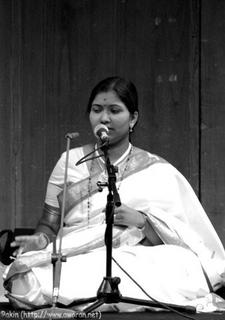
The concert itself drew an eclectic crowd of people to the Purcell Room of South Bank. Obviously intrigued by what sort of performance to expect, the audience awaited the musicians to take the stage and in their demure fashion, they put their hands in form of prayer, a real Indian ‘Hello’, sat down and gave a final tune to their instruments to pitch perfection (the electronic Tambura, the drone box gave the base pitch in it’s twang sound), which is usual in this style of Carnatic music, just before commencing the show. The first sound to be heard was that of Mangalore (the part of India where Aiswariya Rai is from) Lavanya’s sax, which has the quality of sound just like her Guru, Kadri Gopalnath, an earthy almost flute like husky sound, which is bound to capture the ears in an instant.
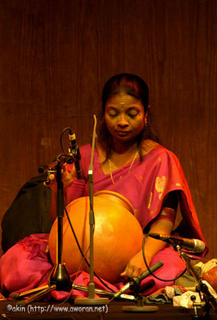
The colourful sarees of the female assembly was indeed eye-catching and with an introduction from Lata, of the first piece in Raga Hamsadwani (Dwani Raag). Lavanya started with a short Aalap(ana) which captured the essence of this lively scale and the fully fledged Ganesha Krithi (the elephant God who is invocated at the beginning of any classical concert) ‘Vaatapi’ (The famous Kriti by one of the holy trinity ‘Thrimurthi’ of Carnatic music, Dikshitar, who alongside Thyagaraja and Shyama Shastri, is akin to Mozart, Bach or Beethoven in terms of composition) was rendered at full force, immediately ‘painting a picture’ to the audience that this group of musicians show the full empowerment of women in Indian Classical music and that technically, they are as competent as any male or mixed ensemble. Thyagaraja’s ‘Samaja Varagamana’ in Hindolam Raga (Malkauns Raag) followed, again with a sweet lilting sax Aalap(ana) encapsulating the Raag in it’s entirety and richly accompanied by the vocals and the stupendous percussion. An unusual trend in this concert was that the vocals were used as accompaniment to the sax, when in actual fact, traditionally, the Vocals come as main and the instrument, traditionally violin, nowadays sax, flute or even keyboard follow – this was indeed a feat for both Lavanya and Maragadhavalli to pull off. The Thani Avartham (percussion solos by the artistes ending in a climax where their rhythms meld together in perfect unison), which was indeed the highlight of the concert for many, showed off the percussion to its best, with the artistes thoroughly enjoying the sparring of rhythmic patterns in it’s tones, sophistication and crescendo. Thyagaraja’s Pancharatna Kriti in Sri Raga, a gem of Carnatic music was performed, to a garland of percussion, which the audience came to expect after the spectacular display of the Thani and then Lavanya performed a radiant Sax solo, the light song, ‘Radha Sametha Krishna’ in the sweet Raga, Yeman Kalyan. Sumaneesa Ranjani Raga, which is quite a rare Raga was chosen by Maragadhavalli for her vocal solo, which came in the form of a Jeyadeva Ashtapathi, her full vocal prowess, purity and range was apparent here. The popular Annamachariya song, Bramhamukha in morning Raga Bowli gave a sharp awakening to anyone who was lulled into relaxation with the fast paced sax dominated piece then came – ‘Tamburi Meeti’, which is a Kannada song by composer Purandaradasar, in the Raga Sindhubairavhi (Raag Bhairavhi) and thus, the concert came to a close without a Thillana (Tharana) but instead, the traditional closing auspicious Raga, Madhyamavati (Raag Madhmad Sarang), was performed in form of Purandaradasar’s ‘Bhagyatha Lakshmi’, flawlessly executed to the audience who showed appreciation by a long cycle of clapping.

This rare concert was indeed a treat to the ears and no doubt, the UK will await the return of the ‘Rhythms of Shakti’ with bated breath, as they are fascinating as they are pure in their form of music. Having toured Egypt, Tunisia, Algeria and South Africa recently, the petite, sweet dexterous Kanjira player, Lata Ramachar in her infinite modesty simply states: “We hope to bring our music to more countries around the world and want to promote not just our group in this form but also pave the way for female musicians who have a talent they would like to share with the world. My fellow group members have worked very hard to achieve this tour and we hope to keep going, adding to the group and sharing Carnatic music with the world.” Here’s hoping that her dreams are fulfilled – playing in Purcell Room, London, is most definitely a pivotal first step to achieving this.

Words by Ashanti OMkar (www.omkari.net)
Pictures by Akin Falope (www.aworan.net)

‘The Little Chilli’ festival has become a well known week in the minds of culture fans around the UK, for its devotion to creating a cultural buzz, handpicking the best and most diverse of talents from the South East of Asia. A brainchild of Sitar maestro, Viram Jasani who runs the Asian Music Circuit (AMC - http://www.amc.org.uk/) in London, he meticulously picks unusual and exciting acts and aims to present them in a form that Westerners and Easterners alike can identify with the sheer universality of music - the one force that has the power to unite the world. With a line up that included ‘Cirebonese mask dance’ from West Java in Indonesia; ‘The spirit of friendship’, where Pakistan and India unite with the Qawwali style of the Nizami Brothers; ‘The Hua family Shawm band’, enlivening gypsy musicians from China, ‘Ustad Ghulam Ali’, the famous Ghazal exponent; ‘Kagura’, one of Japan’s oldest performing art, a colourful and vibrant in form of mask dancing; ‘Mrigya’, something more contemporary in form of a Delhi based fusion band; ‘Hindustani vocal’ in the ‘Gayaki’ tradition, by Piu Sarkhel and Amit Mukerjee and in my opinion, the most important and thrilling of all, the Carnatic (South Indian Classical) ensemble, ‘Rhythms of Shakti’, who bring a new voice to female empowerment by having an all female group of talented musicians from Karnataka.

This extraordinary group of female musicians derive their name, ‘Rhythms of Shakti’ from the female energy source, the ‘Shakti’ a universal force that is known to give the feminine it’s divinity, in different ways, from the courage aspect in Hindu Goddess Durga, to the wealth facet in Hindu Goddess Lakshmi and the knowledge characteristic derived from the Hindu Goddess Saraswathi. Led by Lata Ramachar (BR Lata), the celebrated daughter of Kanjira (Small Indian tambourine) ace, HP Ramachar of Karnataka; this group has taken a few monikers and various musicians have rotated in it’s formation - names such as Mahila Laya Madhuri – which toured in places like Abuja, Nigeria for the commonwealth foundation and also as female Ghatam (clay pot) player, Sukanya Ramgopal’s group ‘Stri Taal Tarang’, a group that Lata was very much part of, again consisting of all female members.

Obviously, this concept may ring a bell, as Anuradha Pal, the Indian Tabla player, student of the great Zahkir Hussain, who also happens to be female and her North Indian variant of ‘Rhythms of Shakti’ called ‘Stree Shakti’ were most celebrated and even went as far as releasing a CD. Lata Ramachar has toured with Anuradha in the past, with Stree Shakti, hence having the sort of experience to be on the international stage. One may ask why this is all so special, the simple answer is that ‘sexism’ exists in India, as it does all over the world and the music side is no exception, where male musicians dominate the field, especially in the percussion arena. Female musicians face many a problem when they decide to learn percussion instruments, one being that particularly South Indian male artistes are reluctant to teach percussion to females and often even refuse to accompany female artistes in their shows, as they feel it demeans their art. This sad scenario has hit many generations, but finally, the light is being seen and groups like ‘Rhythms of Shakti’ are bringing their blend of music to the world, via careful selection by organisations like AMC.

Luckily for Lata Ramachar (who has played for the late MS Subbalakshmi and the great Balamurali Krishna – a definite honour and feat for any female musician), her father took upon the challenge when he saw talent in his daughter and trained her up to a standard that matches any man in her field of playing, the Kanjira in her hands simply ‘sings’; her nimble fingers are dextrous and the rhythmic formations that come out of this tiny tambourine with her miniature hands are simply brilliant in their technique and accuracy. Lata is the only professional Kanjira player that India has to offer, in its rich tapestry of music, but Lata leads the path for many more female percussionists with her hard work and endeavours. HP Ramachar has done an amazing service to the music world by not only training his daughter to this level, but also Vidushi K Shashikala, who is no doubt an excellent Ghatam (Clay Pot) player, who has fingers that do all the talking, deriving the precise sounds of this instrument. HP Ramachar also trained up one other member of the current ‘Rhythms of Shakti’ group, Goka Lakshmi Verma, a formidable Thavil player (this is an instrument that is similar to the Dhol and brings out a very powerful and loud sound if not controlled correctly). Having then asked the great Carnatic multitalented musician, TV Gopalakrishnan, who is not only a vocalist but also an astounding Mirudangist (the Mirudangam is the main South Indian percussion accompaniment, as it has multi tonal sounds from deep bass to percussion treble all in 2 heads) to ‘give’ them 2 of his students, the brilliant nimble-fingered G Lakshmi on the Mirudangam and singer, G Maragadhavalli whose lilting tones provide the melodic element on vocals. The piece de resistance of this ensemble is no doubt young talent, MS Lavanya. A student of the world renowned saxophonist, Kadri Gopalnath, Lavanya is not just pleasing to the eye, but her saxophone playing is a force to be reckoned with, in no un-certain terms. She is the recipient of the prestigious Rajyotsava award in Karnataka and a regular performer who is set to take the Carnatic saxophone style throughout the world, alongside her Brother and Sister, Subbalaxmi and Sudhindra.

The concert itself drew an eclectic crowd of people to the Purcell Room of South Bank. Obviously intrigued by what sort of performance to expect, the audience awaited the musicians to take the stage and in their demure fashion, they put their hands in form of prayer, a real Indian ‘Hello’, sat down and gave a final tune to their instruments to pitch perfection (the electronic Tambura, the drone box gave the base pitch in it’s twang sound), which is usual in this style of Carnatic music, just before commencing the show. The first sound to be heard was that of Mangalore (the part of India where Aiswariya Rai is from) Lavanya’s sax, which has the quality of sound just like her Guru, Kadri Gopalnath, an earthy almost flute like husky sound, which is bound to capture the ears in an instant.

The colourful sarees of the female assembly was indeed eye-catching and with an introduction from Lata, of the first piece in Raga Hamsadwani (Dwani Raag). Lavanya started with a short Aalap(ana) which captured the essence of this lively scale and the fully fledged Ganesha Krithi (the elephant God who is invocated at the beginning of any classical concert) ‘Vaatapi’ (The famous Kriti by one of the holy trinity ‘Thrimurthi’ of Carnatic music, Dikshitar, who alongside Thyagaraja and Shyama Shastri, is akin to Mozart, Bach or Beethoven in terms of composition) was rendered at full force, immediately ‘painting a picture’ to the audience that this group of musicians show the full empowerment of women in Indian Classical music and that technically, they are as competent as any male or mixed ensemble. Thyagaraja’s ‘Samaja Varagamana’ in Hindolam Raga (Malkauns Raag) followed, again with a sweet lilting sax Aalap(ana) encapsulating the Raag in it’s entirety and richly accompanied by the vocals and the stupendous percussion. An unusual trend in this concert was that the vocals were used as accompaniment to the sax, when in actual fact, traditionally, the Vocals come as main and the instrument, traditionally violin, nowadays sax, flute or even keyboard follow – this was indeed a feat for both Lavanya and Maragadhavalli to pull off. The Thani Avartham (percussion solos by the artistes ending in a climax where their rhythms meld together in perfect unison), which was indeed the highlight of the concert for many, showed off the percussion to its best, with the artistes thoroughly enjoying the sparring of rhythmic patterns in it’s tones, sophistication and crescendo. Thyagaraja’s Pancharatna Kriti in Sri Raga, a gem of Carnatic music was performed, to a garland of percussion, which the audience came to expect after the spectacular display of the Thani and then Lavanya performed a radiant Sax solo, the light song, ‘Radha Sametha Krishna’ in the sweet Raga, Yeman Kalyan. Sumaneesa Ranjani Raga, which is quite a rare Raga was chosen by Maragadhavalli for her vocal solo, which came in the form of a Jeyadeva Ashtapathi, her full vocal prowess, purity and range was apparent here. The popular Annamachariya song, Bramhamukha in morning Raga Bowli gave a sharp awakening to anyone who was lulled into relaxation with the fast paced sax dominated piece then came – ‘Tamburi Meeti’, which is a Kannada song by composer Purandaradasar, in the Raga Sindhubairavhi (Raag Bhairavhi) and thus, the concert came to a close without a Thillana (Tharana) but instead, the traditional closing auspicious Raga, Madhyamavati (Raag Madhmad Sarang), was performed in form of Purandaradasar’s ‘Bhagyatha Lakshmi’, flawlessly executed to the audience who showed appreciation by a long cycle of clapping.

This rare concert was indeed a treat to the ears and no doubt, the UK will await the return of the ‘Rhythms of Shakti’ with bated breath, as they are fascinating as they are pure in their form of music. Having toured Egypt, Tunisia, Algeria and South Africa recently, the petite, sweet dexterous Kanjira player, Lata Ramachar in her infinite modesty simply states: “We hope to bring our music to more countries around the world and want to promote not just our group in this form but also pave the way for female musicians who have a talent they would like to share with the world. My fellow group members have worked very hard to achieve this tour and we hope to keep going, adding to the group and sharing Carnatic music with the world.” Here’s hoping that her dreams are fulfilled – playing in Purcell Room, London, is most definitely a pivotal first step to achieving this.

All images are (c) AWORAN (www.aworan.net) and are not to be taken off this Blogspot without photographer's permission. The words are by Ashanti OMkar (www.omkari.net) - please contact via website email for permission if they are to be reproduced and credit must be given to the author and photographer if reproduced anywhere else on the web. They are subject to UK copyright laws and as this was a piece published in a UK newspaper, the words are copyrighted too. Thank you.
